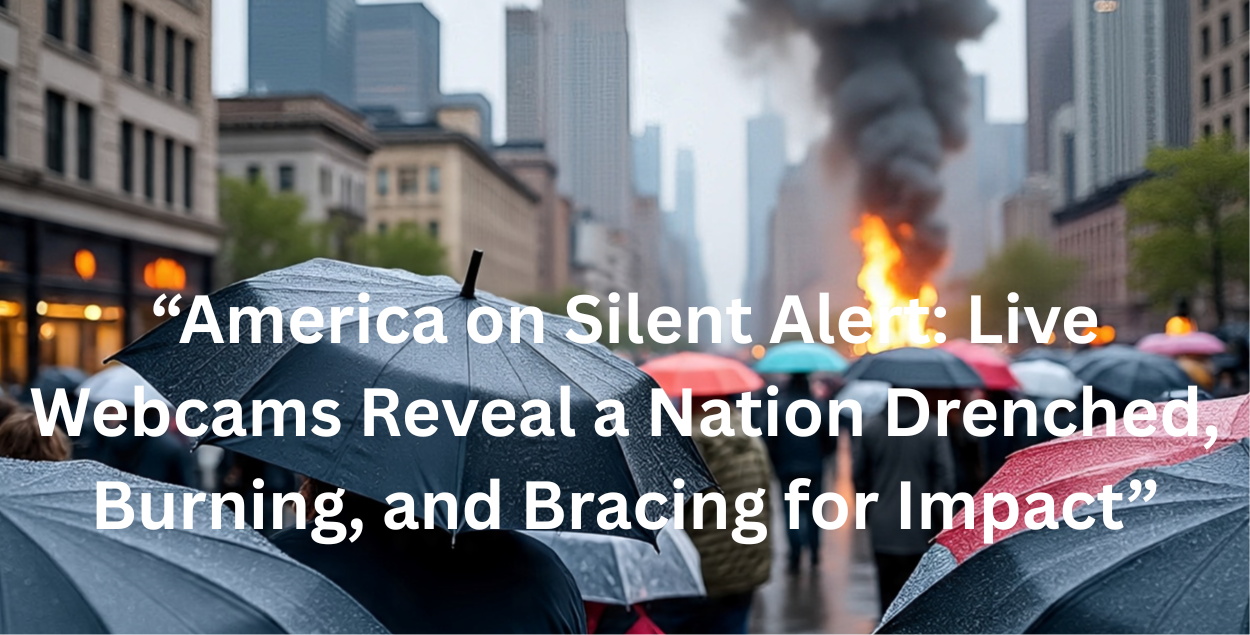FnF News
“Through the Lens of Stillness: July 1 Webcams Reveal a Fragmented, Weather-Beaten, and Watching America”
By Khadija Khan | FNF News | July 2, 2025
In an age of noise, stillness can be shocking. On July 1, a livestreamed feed of webcams from across the United States — hosted under the title “🔴LIVE WEBCAMS around the U.S.A.” — revealed something no press conference or political broadcast could fully capture: the raw visual truth of a nation in flux.
Without a single word spoken, the unfiltered view of America’s cities told a complex story: about climate change, infrastructure strain, human routine, and a rising sense of unease threading through the country’s weather-beaten streets and silent urban sprawl.
This wasn’t just a webcam stream. It was a live, visual editorial on a nation increasingly shaped by forces far greater than any one city, election, or ideology.
New York: Flooded Streets and Failing Systems
At approximately 10:42 a.m. Eastern Time, a static camera mounted over Manhattan’s Eighth Avenue captured a sight New Yorkers know all too well: flash flooding surging through midtown streets. In under an hour, over 1.7 inches of rain fell, overwhelming storm drains and causing water to pool outside subway entrances and building lobbies.
Pedestrians were seen removing their shoes, wading through murky water in suits, school uniforms, and delivery uniforms. Bicycles floated past storefronts. A group of four sanitation workers tried—and failed—to remove a drain blockage outside Madison Square Garden, as traffic honked and sloshed past.
The livestream showed in real time what the city has been warned about for years: climate change is overwhelming the infrastructure of the Northeast, and the flood maps of the 1990s are no longer reliable guides.
The National Weather Service issued a flood warning until 4 p.m. Mayor Eric Adams declared the event “an infrastructure wake-up call”—but many critics pointed out that similar words were used after Hurricane Ida in 2021, and little has changed since.
Chicago: A City Under Heat and Haze
In Chicago, the webcam overlooking Millennium Park caught a less dramatic—but no less alarming—scene: a shimmering heat haze hanging over a slow-moving city. The temperature hit 99°F by noon, pushing the city’s electrical grid into near-overload. Thousands sought shade along the Lake Michigan shore, while others fled the streets entirely.
Time-lapse footage from the Navy Pier webcam showed the city’s skyline darkening behind a wall of wildfire smoke—originating from massive burns still active in western Canada.
By early evening, local utilities began initiating Stage 2 rolling blackouts across several residential zones. The city’s Fire Department confirmed two electrical transformer fires and at least one case of heat stroke requiring hospitalization.
The livestream’s muted visuals—still crowds, stopped buses, shadowed towers—became an accidental documentary of what heat stress looks like when captured across a population of millions.
Miami: Tropical Calm, Threatening Skies
In contrast to the chaos further north, Miami’s beachfront webcams offered eerie beauty: calm surf, scattered tourists, and a horizon thick with gathering clouds.
But that peace was temporary. Off-camera, the National Hurricane Center had issued the season’s first official tropical depression warning. Satellite imagery confirmed a developing system in the Gulf with potential to strengthen into Tropical Storm Isaias within 48 hours.
Scientists from the National Oceanic and Atmospheric Administration (NOAA) noted that ocean temperatures near Florida are now consistently exceeding 88°F, creating ideal conditions for storm formation.
“We’re on the front end of something big,” one climatologist told FNF News. “Miami may look peaceful now, but this stillness is just the inhale before a much larger exhale.”
Los Angeles: Fire Warnings and Urban Emptiness
In Los Angeles, a downtown freeway cam showed something striking: no traffic. During what should’ve been evening rush hour, the 405 looked like a Sunday morning.
The reason? Extreme fire risk. CalFire had issued Level Red warnings across Ventura County, Topanga, and parts of San Bernardino. Temperatures soared above 103°F, while humidity dipped below 5%. Controlled power outages were ordered across sections of the grid to prevent ignition via electrical surges.
Meanwhile, hills above Burbank and Pasadena flickered with smoke. Several small brush fires, visible on elevated webcams, were slowly spreading and prompting preemptive evacuations.
This was not gridlock—it was withdrawal. The city, famously addicted to movement, was pausing out of fear.
A Nation, Quietly Struggling
What makes this story different is that it came without a reporter’s voice, a government official, or a breaking chyron. The silence said everything.
Across multiple time zones, millions witnessed a version of the United States not framed by opinion—but by lens. A flooded café in Brooklyn. A burning hillside in L.A. A darkened office tower in Chicago. A looming storm cloud over Miami Beach.
The cameras didn’t editorialize. They documented.
FNF News Analysis: The Livestreamed State of the Union
The July 1 webcam compilation unintentionally served as a “silent State of the Union.” And the union, while intact, is visibly stretched. Infrastructure is aging. Weather is intensifying. City life is adapting or breaking. And the quiet resilience of citizens—walking through floods, sheltering from heat, watching the skies—remains the only constant.
No politician spoke. No pundit debated. But the country spoke through image. And what it said was clear:
We are not ready.

